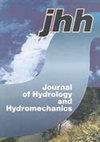长期田间 pH 值控制对土壤微生物活性、憎水性和物理性质的影响
IF 2.4
4区 环境科学与生态学
Q3 WATER RESOURCES
引用次数: 0
摘要
对多种土壤的研究发现,pH 值升高会降低憎水性。在这项研究中,我们在一个长期 pH 值田间试验中测量了块状土壤、团聚体和完整试样的憎水性和一系列其他土壤物理特性,该试验是在可种植轮作作物的单一砂质壤土上进行的,每年通过添加 FeSO4 或 CaCO3 来调节土壤 pH 值,以分别降低或提高 pH 值。在生长季开始时(5 月)和结束时(9 月),将第 3 年的禾本科-白三叶与春燕麦进行比较,以研究作物的影响,从而对土壤结构进行比较。与之前的研究一样,随着土壤 pH 值沿梯度增加,二氧化碳微生物呼吸量增加(p<0.05),但在本研究中,我们发现只有团粒结构和土壤容重受到土壤 pH 值的影响。不同作物的土壤水接触角(p<0.05)以及土壤团聚体的排斥指数存在差异,但土壤 pH 值没有影响。总体而言,数据差异是轮作中各种作物造成的,而不是土壤 pH 值造成的,这表明在添加化学物质以调节土壤 pH 值 55 年后,对土壤物理特性的影响微乎其微。本文章由计算机程序翻译,如有差异,请以英文原文为准。
Long-term field pH manipulation influence on microbial activity, water repellency and physical properties of soil
Studies across multiple soils find increasing pH decreases water repellency. In this study, water repellency and a range of other soil physical properties of bulk soils, aggregates and intact specimens were measured on a long-term pH field experiment on a single sandy loam soil under a ley-arable crop rotation, with soil pH adjustments occurring annually by adding FeSO4 or CaCO3 , to lower or raise the pH, respectively. Crop impacts were investigated by comparing 3rd year grass-white clover to spring oats, at the beginning (May) and end (September) of the growing season to allow soil structure comparisons. As in previous research, increased CO2 microbial respiration (p <0.05) was found with increasing pH along the gradient, but in this study, we found only the aggregate and soil bulk density affected by soil pH. Soil-water contact angles differed between crops (p <0.05), as well as the repellency index of soil aggregates, however, there was no soil pH effect. Overall, differences in data were found to be a result of the various crops in the rotation rather than by soil pH, indicating only minor impacts on soil physical characteristics after > 55 years of chemical additions to amend soil pH.
求助全文
通过发布文献求助,成功后即可免费获取论文全文。
去求助
来源期刊
CiteScore
4.20
自引率
5.30%
发文量
30
审稿时长
>12 weeks
期刊介绍:
JOURNAL OF HYDROLOGY AND HYDROMECHANICS is an international open access journal for the basic disciplines of water sciences. The scope of hydrology is limited to biohydrology, catchment hydrology and vadose zone hydrology, primarily of temperate zone. The hydromechanics covers theoretical, experimental and computational hydraulics and fluid mechanics in various fields, two- and multiphase flows, including non-Newtonian flow, and new frontiers in hydraulics. The journal is published quarterly in English. The types of contribution include: research and review articles, short communications and technical notes. The articles have been thoroughly peer reviewed by international specialists and promoted to researchers working in the same field.

 求助内容:
求助内容: 应助结果提醒方式:
应助结果提醒方式:


